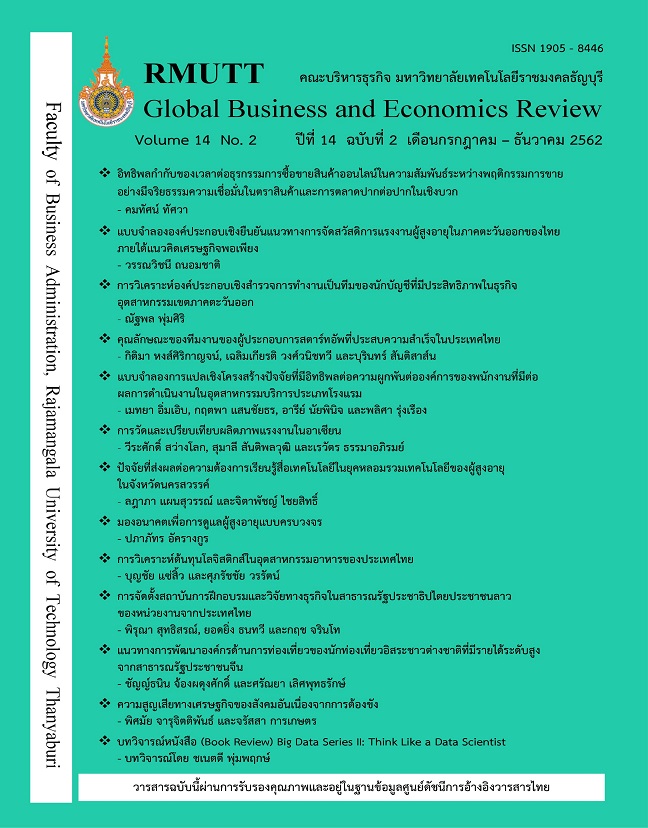A CONFIRMATORY FACTOR ANALYSIS MODEL OF BENEFITS ARRANGEMENT GUIDELINES FOR ELDERLY WORKERS IN EASTERN THAILAND CONCERNING THE CONCEPTS OF SUFFICIENCY ECONOMY
Keywords:
Benefits, Elderly Workers, Eastern of Thailand, Sufficiency EconomyAbstract
This research aimed to confirm a Model of Benefits Arrangement Guidelines for Elderly Workers in Eastern Thailand Concerning the Concepts of Sufficiency Economy with empirical data. The model was developed from previous qualitative research and tested by using a Confirmatory Factor Analysis (CFA). Data was collected through the structural closed-end questionnaires with 360 samples of elderly workers and executive managers in the eastern region of Thailand, and received 312 responses (86.66%). The results confirmed that the model consisting of 3 different approaches that were 1) preparing educations for retirement, 2) establishing welfare policies for the elderly, and 3) collaborating between companies and the aging workforce fit well with the empirical data (c2/df = 1.71, GFI = 0.95, AGIF = 0.92, RMSEA = 0.05, CFI = 0.99, NFI = 0.97). The standard weight of all indicators displayed in this model were found to be statistically significant (P<0.001). The component weight (b) and the ability to explain the components in each factor (R2) showed that providing information on the rights and welfare for the elderly workers (b = 0.94, R2 = 0.89), determination of other financial support policies (b = 0.82, R2 = 0.67), and sharing of sufficiency living experiences with others (b = 0.79, R2 = 0.62) had the highest component weight and the ability to explain components in each aspect by 89, 67 and 62 percent respectively. It could be concluded that the model of benefits arrangements guidelines for elderly workers in Eastern Thailand can be used to describe the benefits arrangements guidelines for elderly workers in Eastern Thailand and areas in the same context.
References
กรมพัฒนาสังคมและความมั่นคงของมนุษย์. (2557). ประชากรสูงอายุไทย: ปัจจุบันและอนาคต. กรุงเทพฯ: ศูนย์เทคโนโลยีสารสนเทศและการสื่อสาร สำนักงานปลัดกระทรวงพัฒนาสังคมและความมั่นคงของมนุษย์.
กรมกิจการผู้สูงอายุ. (2559). กรมกิจการผู้สูงอายุ. สืบค้นจาก https://www.dop.go.th/upload/
knowledge_th_20161305145524_1.pdf
ธุวนันท์ พานิชโยทัย, พิชฎา อารยานุรักษ์, อมรทิพย์ ภิรมย์บูรณ์, วารีรัตน์ ทองสม, เสาวรส หมอนวด, และวิศรุต ตุ้ยศักดา. (2552). นวัตกรรม ภูมิปัญญาเศรษฐกิจพอเพียง องค์ความรู้ของเกษตรกรและชุมชน. กรุงเทพฯ: สถาบันสร้างเสริมนวัตกรรมภูมิปัญญาเศรษฐกิจพอเพียง กรมส่งเสริมการเกษตร.
บรรลุ ศิริพานิช. (2551). คู่มือผู้สูงอายุ: ฉบับเตรียมตัวก่อนสูงอายุ (เตรียมตัวก่อนเกษียณการงาน). กรุงเทพฯ: หมอชาวบ้าน.
มาลี โชคเกิด และเลิศชาย น้อยทรัพย์ (2559). การพัฒนาศักยภาพเครือข่ายการส่งเสริมสุขภาพผู้สูงอายุ จังหวัดอุตรดิตถ์. วารสารสำนักงานป้องกันและควบคุมโรคที่ 10, 14(2), 33-44.
โพสต์ทูเดย์. (2560). สสส.สร้างเครือข่ายผู้สูงวัยดูแลผู้สูงอายุเป็นรูปธรรม. สืบค้นจาก https://www.posttoday.com/social/health/518393
วิจิตร บุณยะโหตระ. (2534). คู่มือเกษียณอายุ. กรุงเทพฯ: บพิธการพิมพ์.
วรรณวิชนี ถนอมชาติ. (2562). แนวทางการจัดสวัสดิการแรงงานผู้สูงอายุในภาคตะวันออก ภายใต้แนวคิดเศรษฐกิจพอเพียง. ชลบุรี: คณะการจัดการและการท่องเที่ยว มหาวิทยาลัยบูรพา.
สุดารัตน์ สุดสมบูรณ์, วิรัตน์ ธรรมาภรณ์, ทวีศักดิ์ พุฒสุขขี และปุญญพัฒน์ ไชยเมล์. (2559). บทบาทขององค์กรปกครองส่วนท้องถิ่นในการดูแลผู้สูงอายุไทย. Journal of Southern Technology, 9(1), 121-128.
สถาบันวิจัยเศรษฐกิจป๋วย อึ้งภากรณ์. (2560). เข้าใจพลวัตรหนี้ครัวเรือนผ่าน Big data ของเครดิตบูโร. สืบค้นจาก https://www.pier.or.th/tag/credit-bureau-data/
สุพิชญา หวังปิติพาณิชย์ (2561). การจัดการทรัพยากรผู้สูงอายุที่มีภาวะพึ่งพิงในยุคประเทศไทย 4.0. Thai Journal of Nursing and Midwifery Practice, 5(2), 111-125.
อรพิน ปิยะสกุลเกียรติ. (2561). การมีส่วนร่วมของชุมชนในการพัฒนาคุณภาพชีวิตผู้สูงอายุในตำบลท่าแค จังหวัดลพบุรี. วารสารร่มพฤกษ์ มหาวิทยาลัยเกริก, 36(3), 46-65.
Atchley, R. C. (1976). The sociology of retirement. New York: John Wiley
Atchley, R. C. (1982). Retirement: Leaving the world of work. Annals of the American
Academy of Political and Social Sciences, 464, 120-131.
Bentler, P. M., Chou, C. H. (1987). Practical issues in structural modeling. Sociological Methods & Research, 16, 78–117.
Hair, J. F., Black, W. C., Babin, B. J., and Anderson, R. E. (2010). Multivariate Data Analysis (7th ed.). New Jursey: Pearson Education.
Schumacker, R. E., and Lomax, R. G. (2015). A beginner's guide to Structural Equation Modeling (4th ed.). New York: Routledge.
United Nation. (2019). World Population Ageing 2019: Highlights. Department of Economic and Social Affairs. New York: United Nation.
Downloads
Published
How to Cite
Issue
Section
License
บทความที่ได้รับการตีพิมพ์เป็นลิขสิทธิ์ของผู้นิพนธ์
ข้อความที่ปรากฏในบทความแต่ละเรื่องในวารสารวิชาการเล่มนี้เป็นความคิดเห็นส่วนตัวของผู้เขียนแต่ละท่านไม่เกี่ยวข้องกับมหาวิทยาลัยเทคโนโลยีราชมงคลธัญบุรี และคณาจารย์ท่านอื่นๆในมหาวิทยาลัยฯ แต่อย่างใด ความรับผิดชอบองค์ประกอบทั้งหมดของบทความแต่ละเรื่องเป็นของผู้เขียนแต่ละท่าน หากมีความผิดพลาดใดๆ ผู้เขียนแต่ละท่านจะรับผิดชอบบทความของตนเองแต่ผู้เดียว







